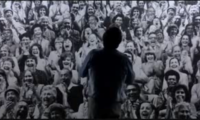“In a society of consumers, no one can be a subject without first turning into a commodity, and no one can keep his or her subjectness without perpetually resuscitating, resurrecting, and replenishing the capacities expected and required of a sellable commodity… The most prominent feature of the society of consumers is… their dissolution into the sea of commodities… In a society of consumers, turning into a desirable and desired commodity is the stuff of which dreams, and fairytales, are made.” — Zygmunt Bauman, “Consuming Life”
Michael Mann, “Miami Vice” (1984/90)
Sometime in the late 80s I watched this show. I was a kid. I watched it with my friend, Nora, who could be mean and cold, and whose actions could be inscrutable, like a boy’s. Who sometimes wouldn’t talk to me for weeks, for no reason, like we were in some romantic relationship that had suddenly, and inexplicably, ended. After a wave of ecstatic bonding, Nora would cut me off. And I would wander the school halls alone, watching Nora flirt with her other friends. Watching Nora seduce new people.
I watched “Miami Vice” with Nora who used to spend every other weekend at her father’s place. She had a TV in her bedroom. I discovered a lot of things with Nora, like sex hotlines, all the rage at the time, Tears for Fears, Channel J, and the first boy I ever loved.
Nora’s father was an artist and took us with him to modern dance recitals, the theater, and parties in Soho. One party was in a warehouse building that overlooked the West Side Highway. Nora and I threw paper airplanes out the window that landed in the Hudson River, which we could barely see, it was so dark, and called sex hotline numbers from the host’s bedroom.
For one party, Nora and I dressed up like Don Johnson and Philip Michael Thomas in “Miami Vice.” We had tried to look like them for a long time. I don’t know where we got the clothes, or why we chose to be those men in particular. I think we already had the clothes and the clothes just dovetailed with the images of the two men. We both had a pair of boat shoes that could pass for loafers. We wore them without socks. We had linen jackets and pants. Bright pink t-shirts. We rolled our sleeves up. I had short, dark hair, like Philip Michael Thomas.
All this was before I discovered Blaine (Andrew McCarthy) and Steff (James Spader) in “Pretty in Pink.” Blaine and Steff are pitched as emotional opposites, yet both are rich and dress the same way. So how can you tell them apart? The movie is about that. Even Blaine doesn’t know the answer until the end of the movie (in the movie’s original ending, which was reshot six months later due to audience disapproval, Blaine didn’t know the answer by the end of the film either). But Andie (Molly Ringwald), who is different, sees how he is different from his friend Steff.
Steff, like Blaine, is attracted to Andie’s difference, but only because he can’t assimilate it. On the other hand Andie isn’t able to really appreciate Duckie’s difference (or his love for her) because Duckie’s difference doesn’t require recuperation (Duckie is played by Jon Cryer). It’s too “pure.” Difference, the movie says, has to be rescued. Difference is a damsel in distress.
Howard Deutch, “Pretty In Pink” (1986)
A lot of teen movies in the 80s were about exteriorizing one’s socio-economic aspirations and formalizing them into adulthood in the form of mature clothing. Clothing that signified a kind of subjunctive adulthood and mainstream success. Even if you weren’t an adult, you were in training to be one, and the clothes — the suits, jackets, and ties at school that weren’t uniforms in the strict sense — meant you could transition into adulthood because, really, there was nothing to transition from. Adult or formal clothing — “power dressing” — was a way of being part of the world, the status quo, which in the 80s was about identifying with the tropes of materialism, power, wealth, greed, success, access. It’s no accident, then, that the business suits women sported in the 1980s as they entered the corporate sphere were referred to as “power suits” (the power suit was parodied to great effect by David Byrne in “Stop Making Sense“). Your life was your business and business was your life. This was before we found cheap ways to look expensive, or expensive ways to be cheap. This was before you could cheat at being rich.
Wearing grown-up clothes in the 80s (see “Less Than Zero,” “Saint Elmo’s Fire,” even “Ferris Bueller’s Day Off”) was thus a way of being tied — primed — to the conventions of the world even before you were emotionally and chronologically prepared to be primed for them. Through your clothes you could look like the outside world. You could show the world you were part of it by dressing like and for it. The market, personified by the yuppie — the market in the flesh — became an identity. Brand names became increasingly important in the 1980s. Ralph Lauren and Calvin Klein became household names.
In “Ferris Bueller’s Day Off,” Ferris, a high school student, plays hooky like a child or adolescent, but spends his day off acting like an adult: dines at a five star restaurant, drives around in a Ferrari 250, goes to an art museum, impersonates adult voices, wines and dines his older-looking girlfriend in the manner of a middle aged, married man. Even the songs Ferris sings at the parade he crashes — “Twist and Shout” by the Beatles and “Danke Schoen” by Wayne Newton — are songs for and by an older generation. Observe, too, all the adult “costumes” Ferris sports in the clip below.
John Hughes, “Ferris Bueller’s Day Off” (1986)
But as much as the 80s were about mainstreaming the alternative, and maturing and commercializing the juvenile (teen movies, The Brat Pack…), it was also about the avantgardization of the mainstream, a time when clothing signified identity and when everything started to get mixed up. As conformist as the 80s were, it was also a decade that was refreshingly incorrigible about its fashion faux pas. We had nefarious teenage-adults like Steff (who wore job clothes. Power clothes), but we also saw people like Andie, Duckie, and Andie’s older, mother-figure friend, Iona, in “Pretty In Pink” (who goes corporate, at least in dress, by the end of the movie), who were retro, romantic, anti-label; “mutants,” as they’re called in the film; whose clothes reflected their anti-conformist sensibilities and interests, signifying not just who they were, but who they weren’t.
What appeals to me most about “Pretty in Pink” is that Andie doesn’t have a good time on her first date with Blaine. She is miserable at Steff’s party. She wants to know why Blaine’s brought her there. Andie shows her disgust. Voices it. Has integrity. But Blaine doesn’t understand. He’s always embarrassed. Unsure of himself. Weak. Andie and Blaine go upstairs to Steff’s bedroom, where Blaine says they can be alone. Instead, they find Steff and his girlfriend, Benny, who bullies and mocks Andie at school, running around half-naked and drunk. Steff is a mixture of self-contempt, cruelty, and arrogance. But he also always knows what Andie’s thinking better than Blaine does. And what Andie’s thinking is what Steff is secretly thinking about himself.
As a woman, Andie has the power to make men question who they are. That’s why she has a man’s name. Andie and Blaine are watching the spectacle of Steff and Benny — the 80s — like it’s a movie inside a movie. A time inside a time. The 80s are turned into a primal scene and “the room becomes a code,” as Jeanette Winterson writes in “Written On The Body,” “that you only have a few minutes to crack.” Blaine is attracted to Andie’s difference — both respects and fears it — and yet he also tries to insinuate Andie into the very things (structure) she is different from because he has nothing different to offer himself. Blaine wants to be different, but he doesn’t want to do anything differently. He wants difference without the difference.
In “Pretty in Pink,” a great deal of emphasis is placed on diagnosing what makes Andie different and what Andie’s difference makes of her. When Andie refuses Steff’s advances, for example, Steff responds with: “I don’t know what makes you so different.” But of course that isn’t true. Steff knows exactly what makes Andie different, and part of that difference is her disavowal of him. Later, at Steff’s party, Benny tells Andie, “You’re an asshole. I don’t want to know what you are,” and Steff is visibly disgusted by Benny. By the things he has. By what and who is like him.
In Jay McInerney’s 1984 novel “Bright Lights, Big City” there is a line about not crossing lines. Lines that don’t exist anymore. About how yuppies wouldn’t go below NYC’s 14th street in the 1980s. Now the yuppie wears the artist and the artist wears the yuppie. Scorsese’s 80s movie “After Hours” offers a parodic rendition of this cross-pollination, where the yuppie is literally encased in art/ist, and the avantgarde/alienaton is Soho at night.
Martin Scorsese, “After Hours” (1985)
Nora and I wanted to go to the Soho party as boys, maybe even as men, because we thought we could pick up boys that way. Attract them by being some version of boys ourselves. We thought we could know and access the world that way too. We knew that boys liked to talk to other boys. We knew that clothes were also about whose bodies they were on. We were power dressing too. But why dress like grown men, in another city, on TV, in a hot climate, like we weren’t two New York girls with alternative, bohemian parents going to a party in the dead of winter in summer clothes? Why did we decide to ape two middle-aged men whose job it was to drive around and capture other men?
I was always more interested in looking than being looked at. Before I knew that I could think what I wanted to think, and feel what I wanted to feel as a girl, I was a boy in my head. As a little girl I was obsessed with male beauty (still am), instead of being concerned about the potentials or logistics of my own. In a culture where to a large extent only women’s beauty is meant to have real value and cache, male beauty mattered to me because I felt that while I might never be a beautiful girl, if I fashioned my outside to match my inside, I might be able to pull off being a cute boy. Moreover, I could probably be the kind of cute, thoughtful boy, cute, thoughtful boys sometimes liked girls to be. More importantly, I thought I could access the strength of girlhood and womanhood through boyhood.
Nora and I thought images belonged to men. We thought images were the road to adulthood and independence. We thought boys could be what they wanted to be. Images taught us, even if our parents didn’t, that men, not women, were independent. Romantic. Creative. We didn’t see the girls we wanted to be onscreen, so we thought being some kind of boy was to be some kind of image.
So how do we tell things apart and draw lines today and why has wanting to still tell some things apart become such a bad thing? In a seen-it-all-before, see-it-all-the-time, interchangeable global world, where can difference be found? Let it be clear that I’m not talking about racial or sexual stereotyping in order to distinguish the “bad guys” from the “good guys,” something our current War on Terror culture and the 80s relished in. As a decade, the 80s was obsessed with classifying and categorizing people. It divided and subdivided (see “The Breakfast Club”: The Jock, The Brain, The Princess, The Criminal). There was always a gap. A hierarchy. A delineation.
The case has and will be made again that all this mixing and matching — mashing-up — blending and blurring is a good thing because it allows us to be free of categories and rules; free of fixed signifiers and binaries; to look like anything and anyone without necessarily being committed to actually being anything (Lady Gaga epitomizes this “freedom”). The Other is now the one who looks like all of us, and all of us look like the Other without actually having to live through and with the alienation (and edification) of Otherness. “I am only well when I am what is necessary to be the other,” writes Pierre Guyotat in “Coma.”
There is a part of Andie that is also still invested in who she isn’t. In having what she doesn’t have. I preferred it when only people like Steff wore Lacoste and Ralph Lauren; people with real money wearing clothes that signified their real socio-economic and socio- cultural position in the world because it allowed me to know my place in the world. It represented a cognitive gap. I knew who and what a Steff was, the world he came with and the world that came with him, the way Andie in “Pretty in Pink” knows who and what a Steff is, and therefore keeps her distance from him. But how can you keep your distance from something or someone if you don’t know who or what that thing is? If you can’t tell anything apart? If that thing looks like you and you like that thing. You can’t, and since you can’t, you don’t, and when you don’t, differences and distinctions are eroded. Dangerously blurred. Sometimes a book is a cover.
Howard Deutch, “Pretty In Pink: The Steff Edit” (1986)
And
Howard Deutch, “Pretty In Pink: 25th Anniv. Extras– James Spader” (1986)
Everything is an image now and the image is now everything. Not just part of who you are and where you came from, the image is now the thing you see, the thing you are, before you do anything. Think anything. Want anything. There is no you first. But there is a me that performs, that is a commodity, which is a notion that comes from a culture of images that are meant to act for us. Instead of us.
While some aspect of difference was clearly the motivation for my identification with gender-bending, with “Miami Vice,” because I was little, I also misjudged what was similar. What I really wanted to be like, and not like, which was not a man with power at all. But a girl who did not want to be divided. I didn’t know yet what power could turn a man, or the world, or me into if I tried to act like one. Nora and I thought about the sameness we were accessing in the form of difference, but we did not think about the difference we were erasing by performing an imitation. By copying a commodified body onscreen offscreen. By trying to be the same when we wanted to be different.
In “Pretty in Pink,” Andie, who makes her own clothes, makes her famous pink prom dress by deconstructing the status quo gown that her father buys her. Andie remakes the dress into something unique, something money can’t buy, in order to transcend her class shame. Check out the pretty tight fitting prom dresses you can wear for your prom. Money is how the rich kids in the film get what they want. Andie conquers and subverts her desire to be the same, to have what everyone has, by re-establishing her difference. By turning a dress that is for everyone into a dress that is just for her. A dress that money can buy, but difference can re-make.
There can be no real, unco-opted difference without gaps; without distance and deference and shock; without the unfamiliar; without the truly weird and incongruous; without carefully distinguishing between the alternative and the mainstream. The only difference that makes a difference is the kind that is challenging, off-putting, even threatening. That kind you cannot instantly appropriate, recuperate, neuter, or sell. Historically, the avantgarde and alternative movements were born of alienation and distance. A gap. Yuppies refusing to go below 14th Street.
In his book “Non-Stop Inertia,” Ivor Southwood calls for a recovery of negativity (resistance):
“Reality TV and social media have eliminated offstage space, destroying mystery and celebrating banality; art slides into decorative commerce; rebellion is commodified and marketed like a fashion brand, as in supposedly alternative rock groups whose superficial revolutionary posturing is belied by a deep musical and cultural conformity and tiresome job-interview positivity. Former punk icons are now insurance salesmen and property developers. New cultural forms based upon ‘distance and reflection’ rather than ‘empathy and feeling’ are called for, to break the stalemate.'”
If we know rich is cheap, talk is cheap, wealth is fake, fake is valuable, real is futile; if signs have been totally demystified, confused, and emptied out; their mystique and power exhausted and drained, then what possible significance and signification can signs — identity — have? How and what can we still signify? Does anyone mean anything they say or do anymore? How do we read signs that are no longer signs, or rather, signs that no longer mean what they signify? How can we read what has become unreadable? How does anyone take a stand with their bodies, their sexes, their faces, their clothes? How do we decipher what’s indecipherable? With a behind-the-scenes to everything — the knowledge of how all things work and what all things become — what power can things still hold and what still holds power? What remains a priori in a posteriori world?
Instead of fashioning his rebellion against the white middle class bourgeois suburban adulthood in which he’s been brought up, Ferris Bueller goes deeper into the fantasy, so that it’s not rebellion at all, but a sign of things to come. Of his life in the future. Of the gap closing. And Ferris’ rivaling sister knows it.
– Masha Tupitsyn








